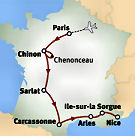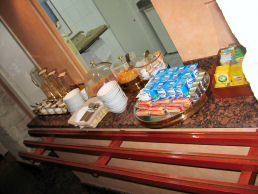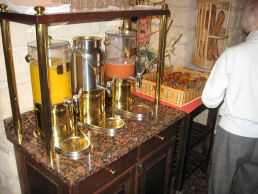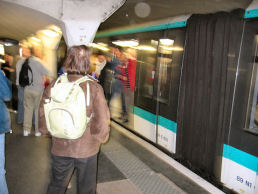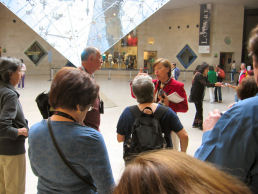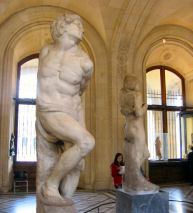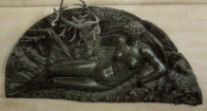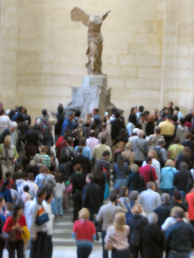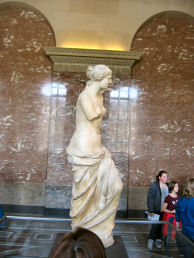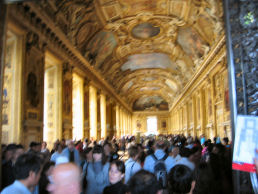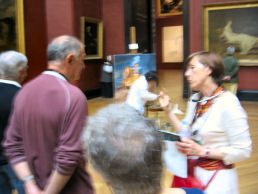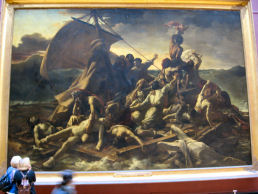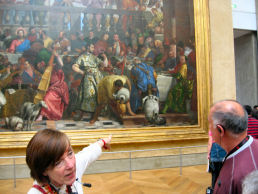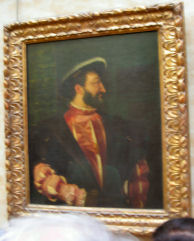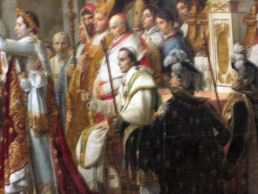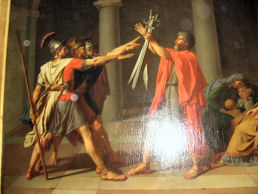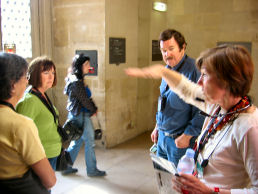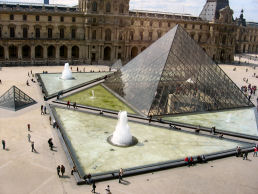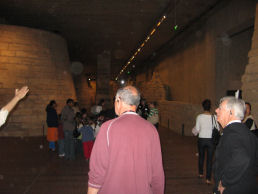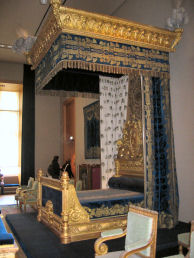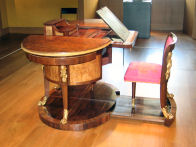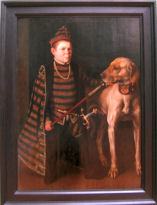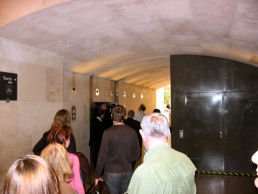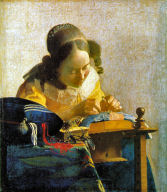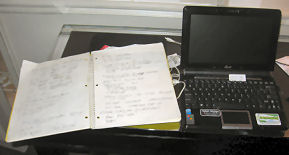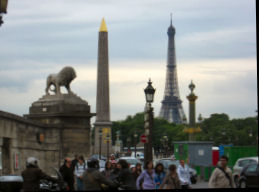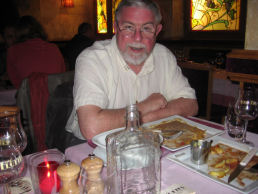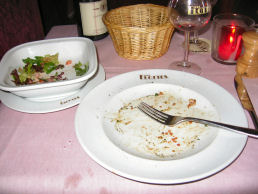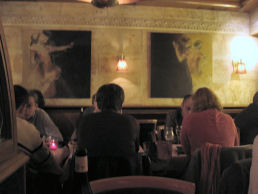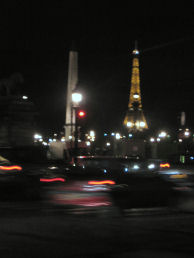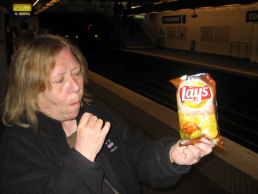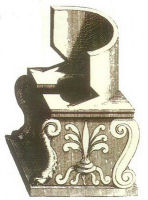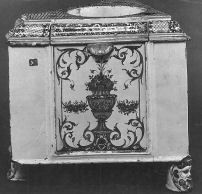I met the Corcorans for breakfast. They told me that the weather had turned a little ugly halfway through the previous evening’s boat ride, but they seemed to enjoy the experience thoroughly anyway. I probably would have been miserable. The breakfast selection was exactly the same as that of the previous two days.
Twenty-six of us assembled to go to the Louvre. Roscoe and Gigi had plans of their own. Sue told me to tell her buddy Phoebe that she would not be coming with us. Patrick once again distributed four Métro tickets to each person. This time we took the #8 train to Concorde, where we switched to #1 to the Louvre. The trains were much more crowded than they had been on Sunday, but we all managed to arrive at the Palais Royal-Musée stop without any problem. We emerged from the Métro tunnels beneath the Louvre and assembled to wait for our local guides. Patrick handed out little radio receivers and earphones. We dropped our backpacks and bags in a bin that was on wheels. Our group of thirteen people was guided by a lady named Elizabeth. She communicated with us through a microphone like the ones that Madonna used. Even though she kept her top on, I thought that she did a terrific job. Elizabeth began by describing the history of the Louvre. It was built by King Charles V as a fortress in the fourteenth century. In the sixteenth century Francis I transformed a small part of the existing structure into a royal residence. It became a museum after the French Revolution. It was remodeled in the 1980’s by I.M. Pei on a commission from President Mitterrand. That is when the pyramid theme was implemented.I took fewer notes than usual. It was hard enough to focus one’s eyes on the artwork and one’s ears on the commentary while picking one’s way through the crowds. We also had to maintain contact with the rest of the group at all times. That was occasionally more difficult than one might suppose.
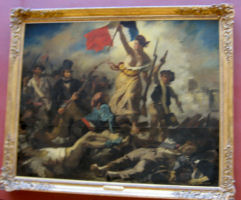
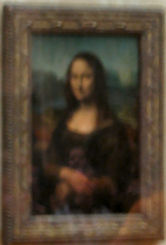
Of course, we also viewed the Mona Lisa from both sides of the room so that we could observe the fact that her eyes always seem to be looking at the viewer. I think that Elizabeth used the term “sfumato” to describe Da Vinci’s technique in portraying the background of his painting. I might have gotten it wrong.
Elizabeth contrasted the Winged Victory statue and the Venus de Milo, which is a few decades more recent.
At one point I thought that I had lost the group. What a strange experience it was to hear Elizabeth very clearly but not to be able to discern the source of the disembodied voice.
When the group broke up, Patti and Tom joined me on my quest to find the Porphyry Chair that Pope Pius VII had allegedly presented to King Louis XVIII. I had read on the Internet that it was in the Louvre. I asked Elizabeth where it might be, and her advice was to try the apartments of Napoleon III in the Richelieu wing. We investigated many rooms in the wing with no success, and we were just about to abandon our search when a very strange event occurred. An alarm went off, and a woman’s voice came over the loudspeaker ordering everyone to abandon the building. She repeated the message in four or five different languages. The strangest thing about it was that hardly anyone seemed to pay any attention to the announcement. Certainly there was no panic.
After a little while, we decided that the wisest course was to head back down to the main area beneath the pyramid. People were leaving the Richelieu Wing, and the building’s security staff was not letting people in. We discovered a small caféteria that was on the ground floor of the wing. The security people seemed unconcerned that people were eating there, so we decided to take a break. Patti and Tom got cappuccinos. I got a sandwich, a bag of chips, and water.
We took our food to a place reserved for customers of the self-serve café. We thought that we qualified, but evidently where we bought our food was a different place. A busboy came over to our table. However, he did not eject us; he only asked us to bus our own trays when we were done, and to take them back outside, which we were happy to do. The sandwich was OK at best, but the chips were pretty good. Tom opined that his cappuccino was devoid of coffee.Patti decided to go ask the information desk about the Porphyry Chair. I wrote down what I was looking for. Before she left the Richelieu Wing to ask about it, Tom asked a security guy if we could go into another wing and then cross over into the Richelieu Wing. I thought that it was silly to make such a ridiculous suggestion, but what do I know? In fact, the security person assured him that we could indeed do this. So, while Patti made inquiries at the information desk, we went over to the Sully Wing.
Patti rejoined us with the news that the person at the information desk had told her that the chair was indeed in room 42 of the Sully Wing on the first floor. As luck would have it, this was the only floor in the entire gigantic museum that was closed for renovation. Patti also said that she saw a picture of it in the museum’s catalog, which the person at the desk said was available on the Internet.[1]
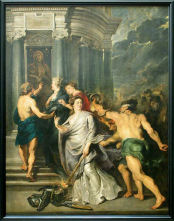
The long walk to the Dutch section of the Richelieu Wing was made even more arduous by the circuitous route prescribed by the security people. Along the way we took time to investigate a few interesting items. One room contained a number of paintings by someone named Weenix. Most of them were of dead animals. I wondered if he had painted all the similar pictures we had seen in Krakow[2] two years earlier. If Picasso could have a blue period, what would prevent the artists of the Low Countries from having a dead animals period?
I was enthralled by the Medici room in the Flemish section. Its walls were filled with very large paintings by Peter Paul Rubens. They portrayed a number of vastly different settings and characters, but every painting included the face of Marie de’ Medici on one subject. I pointed this out to Patti and Tom, but they did not seem to find this as amusing as I did.I was pretty well familiar with Catherine de’ Medici for her role in the St. Bartholomew Day’s Massacre, but I was unacquainted with Marie de’ Medici. She could not be a descendent, could she? If so, her name would certainly not be de’ Medici.[3]
We finally made it to the Dutch rooms. When we had reached the very last one, I still had not seen the Vermeer. Could I have missed it? I took out my map to see what room it was in, and we backtracked to that room. I discovered the spot that was ordinarily occupied by the painting, but it was out on loan to Japan. Bummer. Furthermore, unless we climbed onto the roof, we were just about as far from the exit as it was possible to be.
One could spend weeks in the Louvre and still not take everything in. We saw only a small fraction of it. Art has never been my thing, but I still found the Louvre fascinating. I enjoyed my time there, and I would gladly devote several more days to it.
We found our way back to the hotel on the Métro. I went up to the room and discovered that the maid was in the process of cleaning it. I snatched the Eee PC and my spiral notebook and descended the staircase to the lobby. I found a comfy seat and fired up the computer.I composed a long e-mail to my dad. I was concerned that I had not heard from him. When I was home he sent me an e-mail every day. He can barely see well enough to use the computer, and he does not get around too well. I was somewhat worried that something may have happened to him.
A few minutes after I arrived, Patrick came into the lobby to use the hotel’s computer. If I had his job, I would cough up the $300+ for a netbook in a Paris minute. Ours weighed only three pounds, and it performed like a champ. I had relied on hotel computers and Internet cafés on my first ETBD tour (only because I blew out the power supply/recharger on my laptop at the first hotel), and I did not enjoy the experience at all. On the last two tours I had toted around my oversized laptop.
Surely within a few years everyone on these tours will carry a computer or some kind of device with Internet access. I also expect that the guide would communicate with them through the net. I can envision all kinds of ways of enhancing the total experience.
Patti and Tom came down to the lobby. They let me know that they were going to lunch. Patti indicated that she planned to use the hotel’s computer when they returned.
I looked through the ricksteves.com website to see if anyone had written anything about the Café Constant. There was nothing there, but that situation would be rectified soon enough. I checked the news, the weather, and the sports scores. I was tickled to discover that A.C. Siena, my favorite soccer team, was safely ensconced in Serie A for another year. Then I concentrated on keeping my eyes open and transcribing my handwritten notes to the computer version of the journal.
Across the lobby from me sat a married couple with matching shaved heads. I should say that I assumed that they were married because they had a kid with them. She was working on her laptop. I did not recognize the language that they were speaking; it sounded Slavic to me. After about thirty minutes, a yellow cab pulled up to the hotel, and they got in.A little while later another couple exited a taxi and entered the hotel. He spoke a little too loudly in a southern accent. He tried to get a better rate from the lady at the desk by showing her a book from his briefcase, but it did not work. He identified himself as Cliff.
Cliff asked the lady at the desk what her name was, and she said “Estelle.” She said that she had spent five years in England. I heard Estelle address the lady who occasionally went back and forth from the office as Judy.
After a couple of hours, my last ounce of concentration evaporated. I walked up to the room and took another nap. While I was sleeping, Sue came back. She told me about her pilgrimage to find Edna St. Vincent Millay’s hotel room. She actually did locate it and took some fascinating movies of it. I was shocked to learn that she had walked all the way to the Louvre. I had expected her to stay home and rest her leg. Instead she probably walked farther than we did.
Tom suggested that we try Chez Flottes, a restaurant on the Right Bank near the obelisk, for supper. Sue indicated that she was not interested.While waiting for the Corcorans in the lobby, I told Nancy Kress and Jacqueline Jensen how one wing of the Louvre had been closed off – but not evacuated! – evidently for security reasons. It was news to them.
When we arrived at the École Militaire station, Tom obliged me by pressing the requisite buttons while I took a photo of the Métro board with the lights. It did not come out as well as I hoped because of the glare from the overhead lights.
The ride to the Concorde station was remarkable for one event. A blind fellow boarded the train at La Tour Maubourg by himself. He stood near the door and then left at the next station, Invalides, without any assistance from anyone. His breathing was exceptionally heavy; in fact, I feared that he was going to be sick, which would have made that car a very unpleasant place.
After we exited the Concorde station, we had a pretty nice view of the Obelisk, the Eiffel Tower in the distance, and the Champs Élysée. Tom and I consulted our maps in a manner inspired by Laurel and Hardy. Through perseverance we eventually oriented ourselves and soon spotted the restaurant. It was fancier than I expected, but we were just barely dressed well enough not too feel too self-conscious. Despite the warning on the website that reservations were required, it was not too crowded.We had not been seated for ten minutes when Patti knocked over a glass of the Rhone red wine that we had ordered and spilled it on Tom’s shirt. I felt sympathy for both of them, but I nevertheless considered it a great victory that I was not the first person to spill something on another member of the tour group.
Tom ordered pepper steak, salad, and tiramisu. Patti had her usual tomatoes, basil, and mozzarella (this time bufala) as a starter, chateaubriand, and café crème; I ordered escargots as the starter and surprised everyone by choosing the tartare and a salad. The waiter brought me an espresso afterwards. He served us tap water in a flask, as well as some cookies and candy. The tartare was not bad, and it did not moo, but it was not so good as to override my natural predilection for cooked meat. I doubted that I would order it again. After supper I spent quite a bit of time trying to compose an artistic photo of the Obelisk and the Eiffel Tower. Patti chastised me for knowing how to use neither the night setting nor the timer on my camera. I had to conclude that she was being unreasonable. I had only purchased this camera a little over three years earlier, and I had already figured out how to change the batteries and suppress the flash.On the Métro trip back to the hotel I eavesdropped on two guys standing beside me. One of them said to the other in a British accent, “Have you been to the Bastille? That would be very interesting.”
His companion replied, “I think so, but I don’t remember it.” You cannot make things like this up.
Patti’s craving for potato chips overwhelmed her as we reached the École Militaire station. She purchased a package of them that was flavored with chicken and thyme. I sampled a few, too. They tasted OK at first, but the lingering aftertaste was unpleasant. Neither of us would buy them again.As we approached the hotel we were shocked to encounter Sue headed in the opposite direction. She explained that she was bored and continued on her way.
Upon reaching room #10 I took a shower, worked on the journal for a few minutes, and then packed up most of my things in my big red suitcase. I went to bed in a rather morose mood.
In retrospect we probably should have taken the boat ride on the Seine this evening or at least climbed the Eiffel Tower. To tell the truth, neither one really occurred to me. I had hardly communicated with Sue all day.
I did not enjoy Paris much. It seemed dingy and smoky, and it was way too pricey for my taste. Maybe I did not give the city a fair chance. Paris is the City of Lights, and I basically never saw them. Furthermore, I felt run down the entire time that I was in the city. Even on my best day I had never been of much value to anyone after sundown, and the last few days I had not been at my best.
[1] I found the picture on the Internet. I think that it is just a fancy commode, not the infamous Sella Stercoraria. It does not look like the drawings of the Sella that I have seen. The provenance seemed wrong, too.
[2] I am not sure. The Museum Czartoryski did not allow photos, and my notes are not too extensive.
[3] Catherine was the daughter of Lorenzo de’ Medici, the Duke of Urbino. Marie was actually the daughter of Francesco de’ Medici, the Grand Duke of Florence. She became the second wife of King Henry IV of France and the mother of King Louis XIII. Her period as regent of the latter makes very interesting reading. So, two of the Medici women became queen-consorts of France, and both of them ended up as regents.
